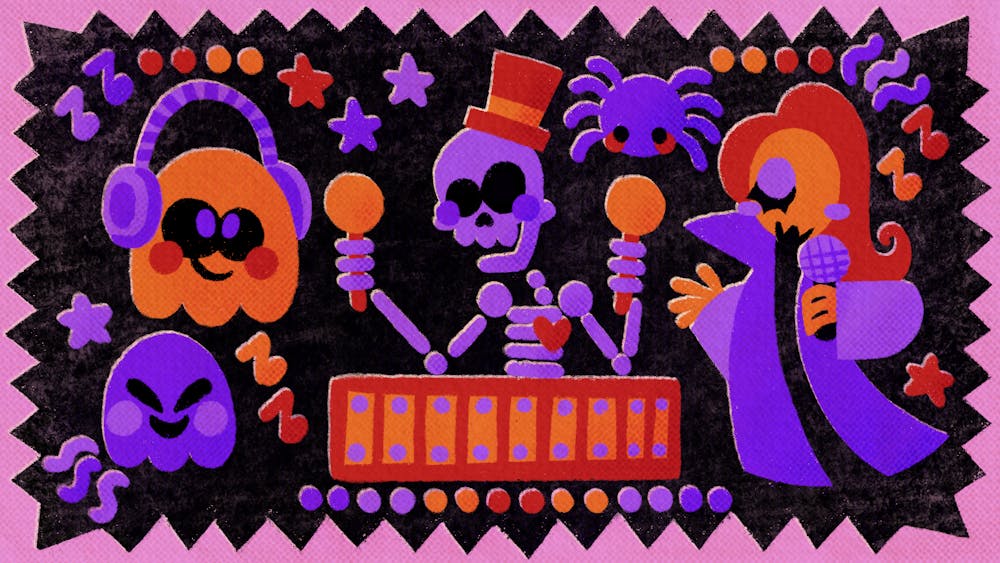Picture this: it’s the beginning of October, and everyone around you has begun setting up spooky decor and planning their slayest costumes for Halloweekend. You go to your nearest Spirit Halloween or Target to get supplies, maybe planning to dress up as Barbie or Oppenheimer. Do you ever notice what music they’re playing on the radio?
In 2023, they are likely playing Taylor Swift’s “Cruel Summer” or Doja Cat’s “Paint the Town Red.” During Halloweekend 2022, the number one song on the Billboard Hot 100 was Swift’s “Anti–Hero.” Go back another year and Adele’s “Easy On Me” was everywhere on Halloweekend. None of these songs sound particularly Halloween–y, and while one might argue that last year’s “Unholy” by Sam Smith and Kim Petras came pretty close to a Halloween–themed song, it’s nothing like the usual Halloween songs that are on everyone’s collective consciousness like Michael Jackson’s “Thriller” or “Monster Mash.” One might begin to wonder: why aren’t there more Halloween songs?
Probably the most likely reason is Halloween’s terrible timing. Holiday decor in America, in general, has been prepped much earlier than before. Just as stores finish their summer sales, Halloween is already on the shelves, in some places by mid–August with their back–to–school section. Neglecting fall and all the pumpkin spice that goes with the season, some families begin setting up decorations in September, even before the autumn equinox. And it’s not like this gives Halloween a longer shelf life: Mariah Carey prematurely begins defrosting near the end of October, as “All I Want For Christmas Is You” slowly sneaks up the Spotify charts before one can even say “Boo!” on Halloween.
This leaves a very small window between September and October for anyone interested in making a Halloween anthem. More often than not, artists stick to a general fall theme (think Swift's Red) or prematurely release their annual Christmas album (Kelly Clarkson and Gwen Stefani are guilty of this). Unlike other seasonal songs for Christmas or even summer songs, a hypothetical Halloween song isn’t given much room to work with. One of the few songs released close to the season that remains a staple today is “Monster Mash” on Aug. 25, 1962, and it was fully intended to be a Halloween song. The only other Halloween songs appear to be those cemented in cult classic Halloween or horror movies, like “Ghostbusters” or “This is Halloween.”
Other “Halloween classics” that we know and love weren’t even intended to be Halloween songs until much later. Michael Jackson’s “Thriller” was released as an album track in November 1982, and his record label, Epic Records, thought the song was too much of a novelty compared to the rest of the album. The iconic music video that went along with it a year later on Dec. 2, 1983, premiering closer to Christmas than Halloween, but it became a hit and later a Halloween staple thanks to Jackson’s insistence and vision. Envisioning the video as a horror–comedy of sorts, the spooky vibes of the music video, paired with the animal growls in the song itself, meant that it was a perfect concoction for Halloween culture in the years to come.
However, it’s worth mentioning that “Thriller” didn’t come without its fair share of controversy. Jackson included a disclaimer for the video saying that the music video does not support the occult or represent his own beliefs, and the video was almost completely scrapped due to his fear of excommunication from his church. This situation could also explain why people are hesitant to release Halloween songs because of the fear of being seen as demonic, thanks to America’s core religious population. A poll conducted by the National Retail Federation found that 73% of the U.S. population plan to celebrate Halloween this year, but many of the remaining 27% are abstaining due to religious reasons, and this proportion has been higher historically. Attitudes have since changed regarding the holiday, but if the discourse surrounding “Unholy” last year is any indication, the American public might not yet be fully convinced of the necessity of a new Halloween anthem. Even non–Halloween moments like a crowd wave during at a Lana Del Rey concert or Taylor Swift donning a cape for “Willow” during the Eras Tour incite loud critics from Christian conservatives ready with angry tweets. Halloween songs just seem to not have a receptive audience waiting for new spooky tunes.
Or do they? TikTok during the Halloween season over the past few years has seen an increasing catalog of audios that people make Halloween fit checks or spooky season makeup trends to. Songs like Lady Gaga’s “Bloody Mary” and Kate Bush’s “Running Up That Hill (A Deal With God)” are now retroactively considered Halloween staples, thanks in part to the Netflix shows that boosted their popularity, but also due to the beloved clock app everyone uses. With TikTok’s ability to propel old songs to virality and its budding microcosm of Halloween subculture, we may see more Halloween songs find their way into our playlists in the future.
Halloween music has been long overlooked, but with modern songs like Lana Del Rey’s “Season of the Witch” cover, China Anne McClain’s “Calling All The Monsters,” or even Phoebe Bridgers’ “Halloween” surfacing around the spooky season, there clearly is a demand for Halloween–inspired music for the sole purpose of existing as such. Christmas songs are constantly revitalized by modern artists through covers of classics, so artists should also consider perhaps revamping Halloween classics. With Halloween culture so prominent in October, it’s time that music catches up.







